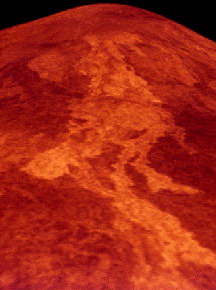This is an image of the eruption of Stromboli volcano.
Click on image for full size
Image from: Dr. J. Alean, Eglisau, Switzerland
For more information, images and video about Stromboli volcano see Stromboli On-Line.
Volcanism
Volcanism is part of the process of bringing material from the deep interior of a planet and spilling it forth on the surface. Eruptions also eject new molecules into the atmosphere. Volcanism is part of the process by which a planet cools off. Even though they are not volcanoes, geysers and hot springs are also part of the volcanic process, involving water and hydrothermal activity. Some planetary bodies, like Jupiter's moon Europa, exhibit icy volcanism, which is another form of volcanism involving water.
There are several ways in which a volcano forms, just as there are several different kinds of volcanoes. On Earth, the most general cause of volcanism is caused by subductionof the Earth's crust.
There are quite a few other planets which have volcanoes on the surface, including Venus, Mars, and Jupiter's moon Io. Other planets exhibit the results of volcanic activity. These include Mercury, the Earth's Moon, Jupiter's moon Europa, and perhaps Neptune's moon Triton.
You might also be interested in:

How did life evolve on Earth? The answer to this question can help us understand our past and prepare for our future. Although evolution provides credible and reliable answers, polls show that many people turn away from science, seeking other explanations with which they are more comfortable.
...more
Volcanic eruptions come in many different forms. Shield volcanoes usually only spew lava and hot gases. These lavas flow slowly down the mountain with speeds of 15 miles per hour or slower. Composite volcanoes
...more
A planetary body, whether the body is a planet or a moon, has to cool off. The warmth contained inside a body controls what sort of surface activity, atmospheric activity, and interior activity which the
...more
There are several ways in which a volcano can form, just as there are several different kinds of volcanoes. Volcanismis part of the process by which a planet cools off. Hot magma, rising from lower reaches
...more
Venus has a number of shield volcanoes such as those found on Earth. Among the volcanoes of Venus are Sif Mons (shown here with a lava plain) and Gula Mons on Western Eistla Regio, Rhea Mons and Theia
...more
The surface of Io is completely volcanic, with lava flows of sulfur from the interior, as shown in this image. White patches in the image are areas of frost made of sulfur dioxide instead of water. The
...more
This picture of the lunar maria shows the difference betwen the highlands, which are heavily cratered, and the dark maria which are relatively smooth with few craters. The absence of craters indicates
...more
This beautiful image of Triton reveals many interesting features of its surface. The surface of Triton is halfway between Ganymede's and Europa's (two of Jupiter's moons). Ancient portions of the surface
...more















